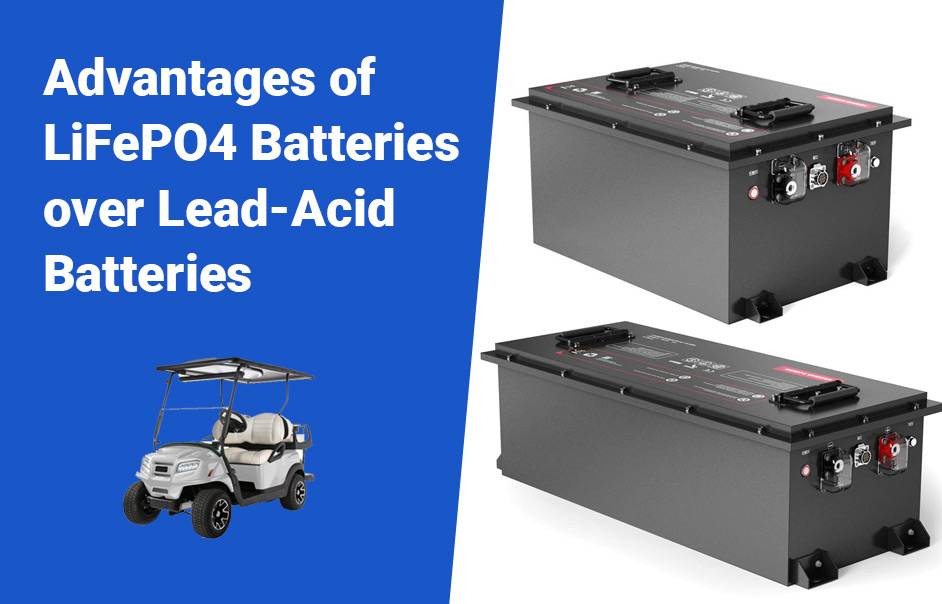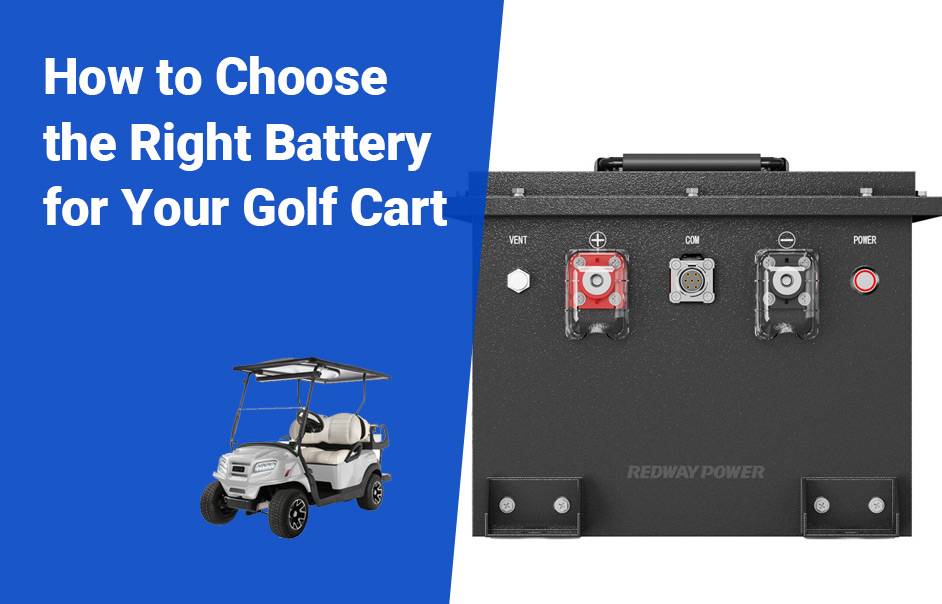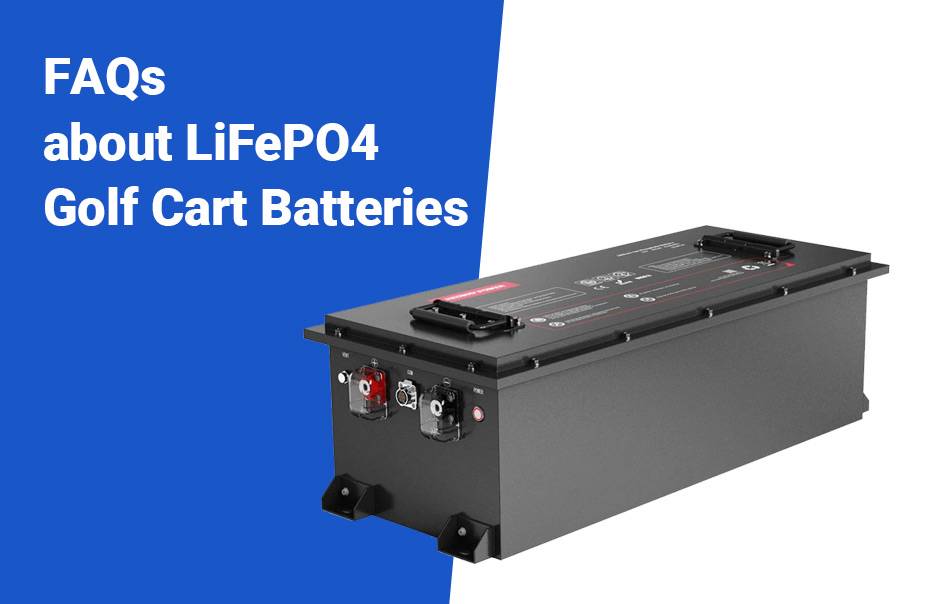Welcome to the ultimate guide on LiFePO4 golf cart batteries! For passionate golfers, having a reliable golf cart battery is crucial. This comprehensive guide explores why LiFePO4 batteries are a game-changer, detailing their advantages over traditional lead-acid batteries. It provides tips on choosing the right battery, along with installation and maintenance guidelines. Join us as we tee off into the world of LiFePO4 batteries and enhance your golfing experience! Also check: Deep Cycle LiFePO4 Golf Cart Batteries Manufacturer Whoelsale Prices
Advantages of LiFePO4 Batteries over Lead-Acid Batteries
Selecting the right battery is crucial for your golf cart’s performance, and LiFePO4 batteries stand out as a superior choice over lead-acid alternatives. Here’s why:
- Extended Lifespan:
- LiFePO4 batteries offer a significantly longer lifespan, lasting up to 10 years or more with proper care, compared to the 3-5 years typical for lead-acid batteries.
- Lightweight Design:
- LiFePO4 batteries are much lighter, contributing to increased energy efficiency and overall improved performance in your golf cart.
- Rapid Charging:
- Unlike lead-acid batteries that require extended charging periods, LiFePO4 batteries can be fully charged in just 2-3 hours, providing quick turnaround times.
- Consistent Power Output:
- LiFePO4 batteries deliver consistent power output throughout their discharge cycle, ensuring optimal and reliable performance on the golf course.
- Enhanced Safety Features:
- With non-toxic materials and a safer composition compared to corrosive acid electrolytes in lead-acid batteries, LiFePO4 batteries prioritize safety.
Choosing LiFePO4 technology for your golf cart not only ensures efficiency but also brings benefits like longer lifespan, faster charging, and increased safety. Make the smart investment in advanced lithium-ion phosphate-based batteries for an elevated golfing experience!
Key Features of LiFePO4 Golf Cart Batteries
LiFePO4 golf cart batteries come equipped with several key features that set them apart:
- Exceptional Lifespan:
- LiFePO4 batteries offer a remarkable lifespan, lasting up to 10 times longer than traditional lead-acid batteries. This longevity makes them a cost-effective choice for avid golfers.
- Lightweight Design:
- Significantly lighter than lead-acid counterparts, LiFePO4 batteries reduce overall cart weight, enhancing maneuverability on the golf course. The lightweight design also facilitates easy installation.
- Fast Charging Ability:
- LiFePO4 batteries stand out with their rapid charging capability. Using the right charger, these batteries can reach a full charge in just a few hours, minimizing downtime and maximizing enjoyment on the course.
- High Energy Density:
- With high energy density, LiFePO4 battery cells store more power in a compact size, maximizing the golf cart’s range and ensuring consistent performance throughout each round.
- Enhanced Safety:
- Safety is prioritized in LiFePO4 batteries, featuring built-in protection against overcharging, overheating, and short-circuiting for worry-free usage.
- Low Self-Discharge Rate:
- Boasting an incredibly low self-discharge rate, LiFePO4 batteries retain charge even during extended periods of inactivity, eliminating concerns about unnecessary power loss.
- Impressive Temperature Tolerance:
- Designed to withstand extreme temperatures better than lead-acid alternatives, LiFePO4 batteries ensure optimal performance in hot or cold weather conditions, suitable for year-round golfing.
LiFePO4 golf cart batteries combine these features to provide a reliable and efficient power source for an enhanced golfing experience.
How to Choose the Right Battery for Your Golf Cart
Selecting the optimal battery for your golf cart involves considering key factors:
- Voltage Requirements:
- Determine your golf cart’s voltage needs, typically operating on a 48-volt system. Verify your specific model for compatibility.
- Capacity (Amp-Hour Rating):
- Assess the battery’s capacity, indicating how long your cart can run before recharging. Account for terrain and usage patterns to determine the appropriate capacity.
- Size and Weight:
- Choose a battery that fits within the limited space of a golf cart without compromising performance or safety. Consider both size and weight constraints.
- Lifespan:
- Evaluate the lifespan of battery options. Lead-acid batteries last around three years, while LiFePO4 batteries can extend up to ten years with proper care.
- Maintenance Needs:
- Consider the maintenance requirements of different batteries. Some LiFePO4 batteries feature built-in monitoring systems for easier maintenance, while others may require regular checks and water refills.
- Charging Capabilities:
- Assess the charging capabilities of potential batteries. Some LiFePO4 batteries offer fast charging, contributing to convenience and minimizing downtime.
By carefully examining these factors, you’ll make an informed decision that aligns with your golf cart’s power requirements, longevity expectations, space limitations, and maintenance preferences – ensuring a satisfying and reliable golfing experience. Also check: Golf Cart Batteries Whoelsale Prices
Installation and Maintenance Tips
Ensure the optimal performance and longevity of your LiFePO4 golf cart batteries with these installation and maintenance tips:
- Proper Positioning:
- Securely position batteries in a well-ventilated area, away from excessive heat or moisture to prevent potential damage.
- Wiring Connections:
- Tighten and secure all wiring connections before powering up your golf cart to avoid voltage drops and ensure efficient battery performance.
- Regular Cleaning:
- Wipe down batteries regularly with a damp cloth to keep them clean. Avoid harsh chemicals that may damage the battery casing.
- Charging Routine:
- Follow the manufacturer’s guidelines for correct battery charging. Overcharging or undercharging can significantly reduce battery lifespan.
- Inspections:
- Periodically inspect batteries for wear or damage, such as bulging cases or leaking fluids. If issues arise, seek assistance from a professional technician.
Proper installation and routine maintenance are crucial to maximize the lifespan of your LiFePO4 golf cart batteries. Following these tips ensures optimal performance on the greens, providing long-lasting power for years to come.
Safety Precautions when Using LiFePO4 Golf Cart Batteries
Ensuring the safe and efficient operation of LiFePO4 golf cart batteries is paramount. Follow these precautions for a secure usage experience:
- Read Manufacturer’s Instructions:
- Familiarize yourself with the manufacturer’s instructions for proper usage, charging procedures, and maintenance requirements before installing or operating the battery.
- Handle with Care:
- Avoid dropping or mishandling batteries to prevent damage or injury. Wear appropriate personal protective equipment (PPE) like gloves and safety glasses during handling.
- Ensure Proper Ventilation:
- Maintain proper ventilation in the battery compartment to prevent the accumulation of potentially harmful gases during charging or discharging processes.
- Regular Inspection:
- Periodically inspect batteries for signs of damage, such as cracks or leaks. Cease usage immediately if abnormalities are detected and seek professional assistance.
- Use Compatible Chargers:
- Only use chargers specifically designed for LiFePO4 batteries during the charging process. Incompatible chargers may reduce performance and pose safety risks like overheating.
- Proper Storage:
- Store batteries in a cool, dry place away from direct sunlight and extreme temperatures. Avoid exposure to water or moisture to prevent corrosion and electrical malfunctions.
By adhering to these safety precautions, you can harness the benefits of LiFePO4 golf cart batteries while maintaining a secure environment for yourself and those around you.
FAQs
Can lithium batteries reach 120-150V in series for golf carts?
How to replace lead-acid with lithium in 2014 EZGO TXT 48 golf cart?
What are the best batteries for an EZGO Freedom golf cart needing 6 new batteries and a charger?
Can individual lithium batteries in golf carts be charged with a 48V charger?
Is it true you can’t extinguish a lithium battery fire?
What are the dangers in golf carts?
More FAQs
How often should golf cart batteries be replaced?
Golf cart batteries typically need to be replaced every 4-6 years, depending on usage and maintenance.
How long do golf cart batteries last on a single charge?
On average, golf cart batteries can last between 25-40 miles on a single charge, but this can vary depending on the battery type and age.
Can I use a regular car battery in a golf cart?
It is not recommended to use a regular car battery in a golf cart, as they are designed for different purposes and may not provide the necessary power and longevity.
How should I maintain my golf cart batteries?
Regular maintenance such as checking water levels, cleaning terminals, and equalizing charge can help prolong the life of your golf cart batteries.
Can golf cart batteries be recycled?
Yes, golf cart batteries can and should be recycled to prevent harmful chemicals from entering the environment. Many battery retailers offer recycling programs.
Can I use LiFePO4 batteries in my existing golf cart?
Yes, LiFePO4 batteries are versatile and can replace lead-acid batteries in most golf carts. Ensure compatibility by checking your specific golf cart model’s specifications.
How long do LiFePO4 batteries last?
LiFePO4 batteries have an impressive lifespan, typically lasting between 8-10 years or more with proper care. This longevity results in fewer replacements and significant cost savings.
Are LiFePO4 batteries safer than lead-acid batteries?
Yes, LiFePO4 batteries are safer. They are non-toxic, stable, and lack the risk of leaking or emitting harmful gases. Built-in safety features, such as thermal stability, reduce the risk of overheating or fires.
Can I charge my LiFePO4 battery with my existing charger?
In most cases, yes. Many standard golf cart chargers are compatible with LiFePO4 batteries due to their similar voltage requirements. Consult manufacturer guidelines or seek professional advice for confirmation.
Do I need regular maintenance for my LiFePO4 battery?
While LiFePO4 batteries require less maintenance than lead-acid batteries, basic upkeep is essential. Regularly check voltage levels, clean terminals, and ensure proper ventilation for optimal performance and longevity.
For specific queries, consult Redway at here.
What is the longest lasting golf cart battery?
These batteries are known for lasting a long time, usually over 10 years and as many as 20 years with proper care. Lithium-ion batteries require little maintenance since you don’t need to add water.
How cold is too cold for a golf cart?
Golf cart batteries freeze in colder temperatures, like any other battery. Although the exact range of temperatures at which freezing occurs can vary among battery types and brands, freezing may occur when temperatures dip below 32°F.
Can you replace golf cart batteries with car batteries?
Short answer- no, replacing a golf cart battery with a car battery should never be done. Lithium golf cart batteries (or even lead acid ones) are deep cycle batteries. However, car batteries are starter batteries. Car batteries provide a very high initial surge of current which is important to start a car.
Can you replace 6 8-volt batteries with 4 12 volt batteries in a golf cart?
48 volts is a common golf cart voltage so no problems with the voltage 6×8= 48 and 12×4=48 so if they have the capacity and are deep cycle no problem.
Will lithium batteries make my golf cart faster?
Lithium golf cart batteries are much lighter. This makes your golf cart easier to maneuver and helps you reach a comfortable speed faster.
How long can a golf cart sit without charging?
Lead-acid batteries may allow for 4-6 weeks of inactivity before needing a charge, while lithium batteries can sit for longer periods due to their charge retention capabilities.
How do you rejuvenate a golf cart battery?
Ultimately the best recommendation for potentially recovering a sulfated battery is to try using a long, slow charge. If you have a battery charger that has a reconditioning or equalizing charge mode on it, that may be your best bet.
How long do deep cycle golf cart batteries last?
That all being said, properly maintained battery packs in fleet carts tend to last about 4-6 years while private owners tend to get about 6-10 years out of their battery packs. Other major factors include the type of options on the cart that may increase the draw from the battery pack.
Should I switch to lithium batteries in my golf cart?
Upgrading your golf cart to lithium can provide many benefits, including longer battery life, increased power, eco-friendliness, faster charging time, and lower total cost of ownership.
Can I use 8 6-volt batteries in a 48 volt golf cart?
For example, a typical 48-volt golf car may use eight 6-volt batteries, six 8-volt batteries, or four 12-volt batteries. Purchasing fewer batteries with a higher voltage is appealing because it reduces your upfront cost.
What’s the difference between a golf cart battery and a deep cycle marine battery?
Golf cart batteries, like 6-volt deep cycle ones, have larger plates designed to hold power over extended periods, whereas marine batteries have smaller plates. These differences affect their performance and suitability for specific applications.
Is it bad to run golf cart batteries all the way down?
Avoid fully discharging golf cart batteries or exceeding 80% discharge to extend their lifespan. Regular testing with tools like hydrometers or voltage testers helps monitor battery health.
Can I replace 6 6-volt batteries with 3 12-volt batteries in a golf cart?
Yes, if the 12-volt batteries fit and are connected in series. This configuration maintains the required voltage for the golf cart to operate properly.
Can I use 3 12-volt deep cycle batteries in a golf cart?
While using 3 12-volt marine batteries may improve performance temporarily, it’s essential to ensure compatibility and monitor battery health, as indicated by decreased performance after sitting for three weeks.
Can I put deep cycle batteries in my golf cart?
Golf carts benefit from deep cycle batteries designed for regular discharge and recharge cycles, ensuring reliable performance over time.
Can I put 4 12-volt batteries in a 36-volt golf cart?
No, a 36-volt golf cart typically requires six 6-volt batteries or three 12-volt batteries to achieve the correct system voltage for optimal operation.
Can I put 4 12-volt batteries in my 48-volt golf cart?
Yes, by connecting three or four 12-volt batteries in series, you can provide the necessary voltage for a 48-volt golf cart motor.
Can I leave my golf cart outside all winter?
While golf carts can withstand outdoor storage, prolonged exposure without protection can lead to damage and decreased performance. It’s advisable to take measures to protect the cart during winter.
How many years should a golf cart last?
The lifespan of a golf cart varies depending on factors such as usage, maintenance, and environmental conditions. On average, carts last between 7 to 10 years, with proper care potentially extending their lifespan beyond this timeframe.
Can you leave batteries in a golf cart over winter?
It’s advisable to disconnect golf cart batteries during winter storage to prevent potential discharge and preserve battery charge.
Why are my golf cart batteries dying so fast?
The lifespan of golf cart batteries depends on driving and charging behavior. Frequent use or longer distances can lead to faster battery wear, while infrequent use may extend battery life.
How often do golf cart batteries need water?
Check water levels in golf cart batteries at least once every two months. New batteries may require water addition every other month, with more frequent checks recommended during hotter months due to increased evaporation rates.
Should you charge golf cart batteries every day?
It’s recommended to recharge batteries after each day’s use. When charging, flip the RUN/TOW switch to “TOW” to avoid controller damage. If possible, charge between uses. When adding DISTILLED water, avoid overfilling to prevent electrolyte loss.
How long does it take to replace a golf cart battery?
On average, golf cart batteries last between 4 to 6 years, equating to approximately 500 to 1,500 hours of usage. However, lifespan can vary based on several factors.
Why does the water in my golf cart battery bubble when charging?
Bubbling or gurgling sounds during charging are normal, especially with new batteries. This process, known as curing the lead, is essential for solidifying new lead within the batteries.
How can I test my golf cart battery at home?
Use a voltmeter to test battery voltage. Healthy batteries typically read about 50 to 52 volts. Ensure proper contact by touching the negative probe to the battery’s ground or negative terminal and repeating with the positive probe.
Why are my electric golf cart batteries not charging?
Check battery water levels, cables for corrosion or looseness, and charger cables’ condition. Refill with distilled water to the appropriate level, ensuring it’s 1″ below the top.
Can you mix old and new batteries in a golf cart?
Mixing old and new batteries can lead to overcharging and shortened lifespan for newer batteries. It’s best to replace batteries as a set to maintain uniform performance and charging.
Can I overcharge my golf cart batteries?
Overcharging should be avoided, as it can significantly impact battery lifespan. Proper charging practices, such as avoiding prolonged charging periods, are essential for battery health.
Can I mix brands of golf cart batteries?
Mixing battery brands can be dangerous due to potential incompatibility of chemicals and battery acids. This mixing could damage all batteries in the pack, emphasizing the importance of uniformity in battery selection.
Also check: Deep Cycle LiFePO4 Golf Cart Batteries Manufacturer Whoelsale Prices
What drains a golf cart battery?
Remember to turn off lights, the radio, and other electrical components when the golf cart is idling or not in use to prevent full discharge.
Can I charge a 48-volt golf cart with a 12-volt battery charger?
No, but connecting four identical 12V chargers in series can provide a 48V output to charge a 48V battery.
Can I replace 6-volt golf cart batteries with 12-volt batteries?
It depends on the battery configuration. If the cart has four 6V batteries connected in series, you can replace them with two identical 12V batteries. Otherwise, it may not be possible.
Does a 48-volt golf cart go faster than a 36-volt golf cart?
Yes, typically a 48V golf cart will have higher speed capabilities compared to a 36V cart due to differences in battery configuration.
How can I extend my golf cart battery life?
Charge the batteries overnight after each use, regardless of the duration. Allowing batteries to sit in a low state of charge for extended periods can decrease their capacity and lifespan.
How long can a golf cart sit without charging?
Lead-acid batteries may last 4-6 weeks without charging, while lithium batteries can sit for longer periods due to their charge retention capabilities.
Is a lithium battery better for a golf cart?
Lithium batteries offer faster charging times compared to lead-acid batteries, making them advantageous for golf carts.
Why are golf cart batteries more expensive than car batteries?
Golf cart batteries, especially deep-cycle lead-acid batteries, have a more complex internal structure designed for prolonged use and higher discharge rates, leading to higher manufacturing costs.
Are Interstate golf cart batteries any good?
Interstate Extreme Cycle Batteries are highly regarded for their high reserve capacity, long runtime, and cycle life.
How much does it cost to replace batteries in a 48-volt golf cart?
Prices vary based on type, capacity, and brand. Traditional lead-acid batteries typically range from $100 to $200 per battery, with a complete set for a standard 36V or 48V golf cart ranging from $600 to $1200.
Can I use 3 12-volt marine batteries in my golf cart?
It’s not recommended, as marine batteries may not be within the proper temperature range for optimal charging in a golf cart application. It’s best to use batteries specifically designed for golf carts.
Can I replace 6 6-volt batteries with 3 12-volt batteries in a golf cart?
Yes, if they are connected in series and the 12-volt batteries fit. This configuration is feasible for achieving the required voltage.
Can you put any battery in a golf cart?
While it’s possible to use car batteries in a golf cart, it’s important to note that golf carts typically require deep cycle batteries designed for prolonged power delivery.
Are Trojan golf cart batteries worth the money?
Yes, Trojan batteries are considered superior for their performance, lifespan, and durability compared to other brands.
What is the longest-lasting golf cart battery?
UPG (Universal Power Group) batteries are renowned for their longevity and premium build quality, making them a top choice among golf cart owners.
Can I put 4 12-volt batteries in a 36-volt golf cart?
No, using lower voltage batteries than the specified requirement will not provide sufficient power for proper cart operation.
Can I replace just one bad battery in my golf cart?
It’s not recommended as it may lead to uneven performance and potentially higher costs over time. Replacing all batteries is usually the best solution.
Can dead golf cart batteries be restored?
Sulfated batteries may potentially be recovered with a long, slow charge using a charger with reconditioning capabilities.
How do you know when golf cart batteries are bad?
Extended charging times compared to normal or a noticeable decrease in performance may indicate failing batteries.
Is it bad to leave a golf cart plugged in all the time?
Yes, constant full charging can degrade the battery more quickly, reducing its lifespan.
Can I put deep cycle batteries in my golf cart?
Yes, deep cycle batteries are suitable for golf carts as they are designed for regular discharge and recharge cycles.
Can I put 4 12-volt batteries in my 48-volt golf cart?
Yes, connecting four 12-volt batteries in series can provide the necessary 48-volt output for the golf cart.
Can you use regular 12-volt batteries in a golf cart?
While standard car batteries can be used, their design may not provide optimal performance for golf cart usage.
How many years do golf cart batteries last?
Properly maintained battery packs typically last between 4-6 years for fleet carts and 6-10 years for private owners.
How much does it cost to replace a golf cart battery?
Replacement costs can range from $800 to $1500, depending on the number and type of batteries needed.
What type of battery is best for a golf cart?
Lithium batteries offer consistent power and speed without voltage dips, making them ideal for golf carts.
Also check: Deep Cycle LiFePO4 Golf Cart Batteries Whoelsale Prices



















